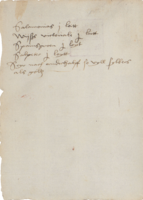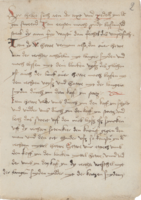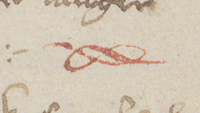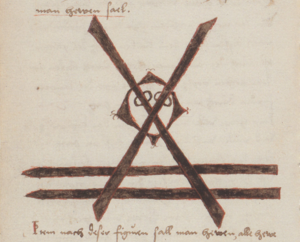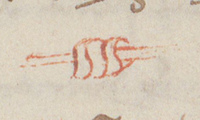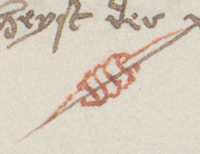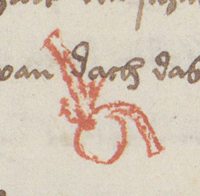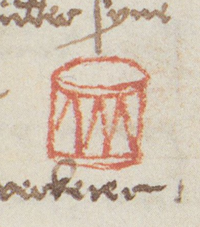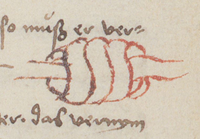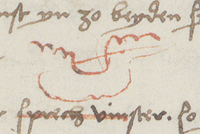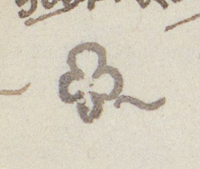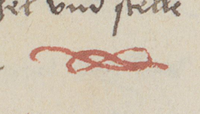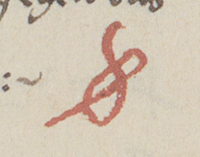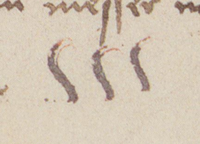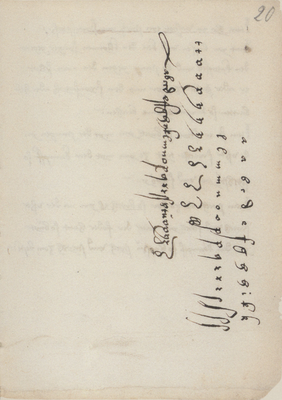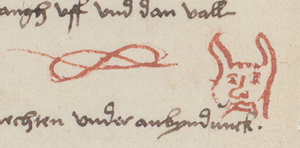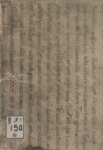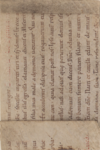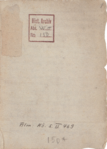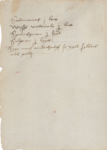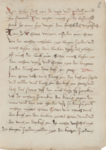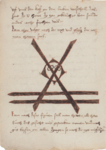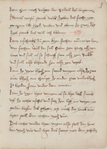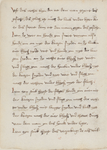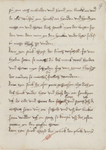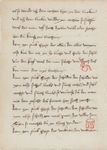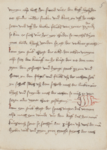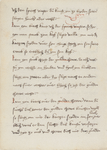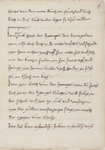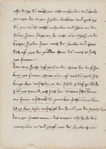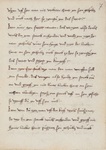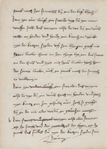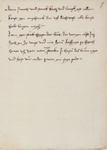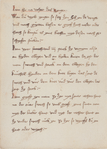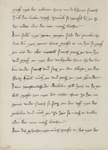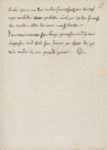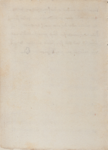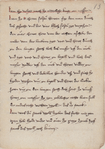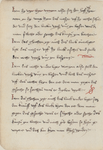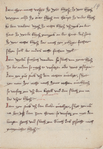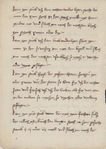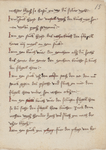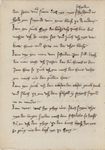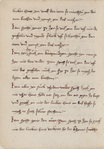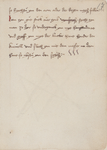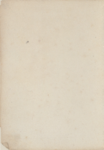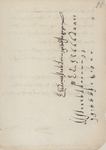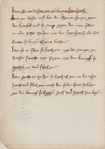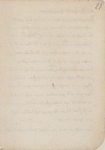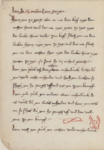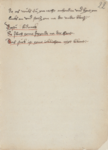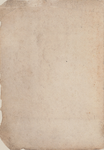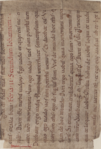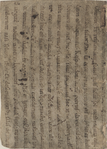|
|
You are not currently logged in. Are you accessing the unsecure (http) portal? Click here to switch to the secure portal. |
Difference between revisions of "Kölner Fechtregeln (MS Best.7020 (W*)150)"
| (80 intermediate revisions by 4 users not shown) | |||
| Line 1: | Line 1: | ||
{{Infobox manuscript | {{Infobox manuscript | ||
<!----------Name----------> | <!----------Name----------> | ||
| − | | name | + | | name = [[name::Kölner Fechtregeln]] |
| − | | location | + | | location = [[inventory::MS Best.7020 (W*)150]], [[museum::Historisches Archiv der Stadt Köln|Historisches Archiv]]<br/>Cologne, Germany |
<!----------Image----------> | <!----------Image----------> | ||
| − | | imageleft | + | | imageleft = File:MS Best.7020 W-150 01v.png |
| − | | imageright | + | | imageright = File:MS Best.7020 W-150 02r.png |
| − | | width | + | | width = x200px |
| − | | caption | + | | caption = ff 1v - 2r |
<!----------General----------> | <!----------General----------> | ||
| − | | | + | | Hagedorn's catalog = [[HS::K]] |
| − | | Wierschin's catalog | + | | Wierschin's catalog= [[WC::20]] |
| − | | Hils' catalog | + | | Hils' catalog = [[HK::25]] |
| − | | Beck catalog | + | | Beck catalog = — |
| − | | Also known as | + | | Also known as = MS W.* 8 150 |
| − | | Type | + | | Type = {{plainlist |
| − | | Date | + | | [[type::Fencing manual]] |
| − | | Place of origin | + | | [[type::Wrestling manual]] |
| − | | Language(s) | + | }} |
| − | | Scribe(s) | + | | Date = ca. [[year::1500]] |
| − | | Author(s) | + | | Place of origin = |
| − | | Compiled by | + | | Language(s) = [[language::Early New High German]] ([[wikipedia:Ripuarian language|Ripuarian]]) |
| − | | Illuminated by | + | | Scribe(s) = |
| − | | Patron | + | | Author(s) = Unknown |
| − | | Dedicated to | + | | Compiled by = |
| + | | Illuminated by = | ||
| + | | Patron = | ||
| + | | Dedicated to = | ||
<!----------Form and content----------> | <!----------Form and content----------> | ||
| − | | Material | + | | Material = |
| − | | Size | + | | Size = 23 [[folia]] (100 mm × 145 mm) |
| − | | Format | + | | Format = Double-sided |
| − | | Condition | + | | Condition = |
| − | | Script | + | | Script = |
| − | | Contents | + | | Contents = |
| − | | Illumination(s) | + | | Illumination(s) = |
| − | | Additions | + | | Additions = |
| − | | Exemplar(s) | + | | Exemplar(s) = |
| − | | Previously kept | + | | Previously kept = |
| − | | Discovered | + | | Discovered = |
| − | | Other | + | | Other = |
| − | | Website | + | | Website = {{plainlist |
| − | | | + | | [https://historischesarchivkoeln.de/archive.xhtml?id{{=}}Vz++++++90003436PPLS#Vz______90003436PPLS Library catalog entry] |
| − | | | + | | [http://www.handschriftencensus.de/13145 Handschriftencensus] |
| − | |||
}} | }} | ||
| − | '''''Fechtregeln''''' ("Fencing Rules"; MS | + | | Images = [http://historischesarchivkoeln.de/viewer/?fileName{{=}}https%3A//historischesarchivkoeln.de/mets%3Fid{{=}}0C2E0266-21A4-4221-9872-B1A371DCFF62_150_Mikrofilm_20160803173250.xml Microfilm scans] |
| + | | Translations = {{French translation|http://gagschola.bluemindmusic.com/files/recherche/dj.trad.hsbest7020.pdf|1}} | ||
| + | | below = | ||
| + | }} | ||
| + | {{foreignchar|Koelner Fechtregeln (MS Best.7020 (W*)150)|ö}} | ||
| + | The '''''Kölner Fechtregeln''''' ("Fencing Rules"; MS Best. 7020 (W*)150) is an anonymous [[nationality::German]] [[fencing manual]] created around the turn of the 16th century.<ref name="Handschriftencensus">Matthias Johannes Bauer. "[http://www.handschriftencensus.de/13145 Köln, Hist. Archiv der Stadt, Best. 7020 (W*) 150]". ''Handschriftencensus. Eine Bestandsaufnahme der handschriftlichen Überlieferung deutschsprachiger Texte des Mittelalters.'' October, 2009. Retrieved 7 July 2012.</ref> It currently rests in the holdings of the [[Historisches Archiv der Stadt Köln]] in Cologne, Germany; it was housed in the wing of the Archive that collapsed on 3 March 2009,<ref>Newspaper article [http://www.noz.de/deutschland-welt/vermischtes/artikel/211493/verschollen-und-doch-gerettet-osnabrucker-historiker-reproduziert-eine-beim-einsturz-des-kolner-stadtarchivs-verloren-gegangene- Neue Osnabrücker Zeitung 01.03.2010]</ref> but it was recovered and seems to have been undamaged.<ref>Personal report from one of the salvage workers.</ref> | ||
| + | |||
| + | The ''Kölner Fechtregeln'' contains several verses resembling [[Johannes Liechtenauer]]'s [[Recital]], but it has few other obvious parallels to the teachings of the high master.<ref name="Handschriftencensus"/> However, as [[Jay Acutt]] points out, it does bear a certain resemblance to the syllabus of the [[Marxbrüder]] fencing guild as described by [[Hans Sachs]].<ref>[[James Acutt]]. [http://paleo.eskirmology.co.uk/best-7020-fechtbuch/ "The Fight-Lore of the Long Sword From the Kölner Fechtbuch (MS Best.7020)".] ''Paleoeskirmology Historical Combat Systems''. Retrieved 24 June 2012.</ref> | ||
== Provenance == | == Provenance == | ||
| − | The known provenance of the MS | + | The known provenance of the MS Best. 7020 (W*)150 is: |
* Created in ca. 1500<ref name="Handschriftencensus"/> by an anonymous scribe; the dialect of German used in the text ([[wikipedia:Ripuarian language|Ripuarian]]) suggests an origin in Cologne, Germany.<ref>''Handschriftencensus Rheinland. Erfassung mittelalterlicher Handschriften im rheinischen Landesteil von Nordrhein-Westfalen mit einem Inventar''. Ed. Günter Gattermann. 1993. Vol. 2, pp. 1319f. (Nr. 2488)</ref> | * Created in ca. 1500<ref name="Handschriftencensus"/> by an anonymous scribe; the dialect of German used in the text ([[wikipedia:Ripuarian language|Ripuarian]]) suggests an origin in Cologne, Germany.<ref>''Handschriftencensus Rheinland. Erfassung mittelalterlicher Handschriften im rheinischen Landesteil von Nordrhein-Westfalen mit einem Inventar''. Ed. Günter Gattermann. 1993. Vol. 2, pp. 1319f. (Nr. 2488)</ref> | ||
* before 1824 – acquired by scholar and collector Ferdinand Franz Wallraf (donated upon his death, 1824). | * before 1824 – acquired by scholar and collector Ferdinand Franz Wallraf (donated upon his death, 1824). | ||
| − | * 1824- | + | * 1824-present – held by the [[Historisches Archiv der Stadt Köln]]. |
| − | |||
== Contents == | == Contents == | ||
| − | {| class=" | + | {| class="treatise" |
|- | |- | ||
| − | ! id="page" | | + | ! id="page" | 1r |
| − | + | | Blank | |
|- | |- | ||
| − | ! | + | ! 1v |
| − | | {{ | + | | {{treatise begin |
| − | | title | + | | title = Metallurgical recipe |
| − | | | + | | width = 90em |
| − | |||
}} | }} | ||
| − | {| class=" | + | {| class="treatisecontent" |
|- | |- | ||
| − | ! | + | ! <p>Images</p> |
| − | + | ! <p>{{rating|m}}</p> | |
| − | ! {{rating|m}} | + | ! <p>Transcription{{edit index|Kölner Fechtregeln (MS Best.7020 (W*)150)}}<br/>by [[Dieter Bachmann]]</p> |
| − | |||
| − | ! Transcription | ||
| − | by [[Dieter Bachmann]] | ||
| − | |||
| − | |||
| − | |||
| − | |||
| − | |||
|- | |- | ||
| | | | ||
| | | | ||
| − | | | + | | {{paget|Page:MS Best.7020 W-150|01v|png}} |
| − | |||
| − | |||
| − | |||
| − | |||
| − | |||
| − | |||
| − | |||
|} | |} | ||
| − | {{ | + | {{treatise end}} |
|- | |- | ||
! 2r - 8r | ! 2r - 8r | ||
| − | | {{ | + | | {{treatise begin |
| − | | title | + | | title = Anonymous long sword pieces |
| − | | | + | | width = 90em |
| − | |||
}} | }} | ||
| − | {| class=" | + | {| class="treatisecontent" |
|- | |- | ||
| − | ! | + | ! <p>Images</p> |
| − | + | ! <p>{{rating|B}}<br/>by [[Christian Trosclair]]</p> | |
| − | ! {{rating| | + | ! <p>Transcription{{edit index|Kölner Fechtregeln (MS Best.7020 (W*)150)}}<br/>by [[Dieter Bachmann]]</p> |
| − | by [[Christian Trosclair]] | ||
| − | ! Transcription | ||
| − | by [[Dieter Bachmann]] | ||
|- | |- | ||
| | | | ||
| − | | | + | | <p>{{red|b=1|Here begins the text and curriculum of the long sword. First, make good footing and stretch your arms free. Whatever you then fence, this sets it up.}}</p> |
| − | + | | {{section|Page:MS Best.7020 W-150 02r.png|1|lbl=02r}} | |
|- | |- | ||
| − | | | + | | [[file:MS Best.7020 W-150 detail 01.png|200px|center]] |
| − | | | + | | <p>Likewise: Understand the 5. cuts like this: The descending cut from the right shoulder with the long edge and take position with your left foot. The left descending cut is also the same; take position with the right foot and cut through the head with the long edge in the plunge.</p> |
| − | | | + | | {{section|Page:MS Best.7020 W-150 02r.png|2|lbl=-}} |
|- | |- | ||
| | | | ||
| − | | | + | | <p>Likewise: Cut back around through their head into the schylt<ref>schylt: 1)shield. 2) to push off with an oar. a rudder pole. 3)shaved or peeled</ref> and back through in the opposite direction into the plunge and lay the sword upon your back, allow it to sink to the right side. Turn your pommel against your opponent and your point out behind, so that you arrive in the right middle cut. Cut in front of yourself, across the head into the left middle cut and back across into the head into the right changer with the long edge down. [Cut] with the short edge up around the head into the left change. These are the 5. cuts. One shall learn each if you otherwise wish to fence properly.</p> |
| − | | | + | | |
| + | {{section|Page:MS Best.7020 W-150 02r.png|3|lbl=-|p=1}} {{section|Page:MS Best.7020 W-150 02v.png|1|lbl=02v|p=1}} | ||
|- | |- | ||
| − | + | | [[file:MS Best.7020 W-150 detail 02.png|300px|center]] | |
| − | | | + | | <p>{{red|b=1|Likewise: The text and gloss follows hereafter [on how] one shall cut.}}</p> |
| − | + | ||
| + | <p>Likewise: One shall cut according to these figures, all cuts through the face with outstretched arms and make good footing in all things, so you do not make yourself mess up.</p> | ||
| + | | {{section|Page:MS Best.7020 W-150 02v.png|2|lbl=-}} | ||
|- | |- | ||
| − | | | + | | [[file:MS Best.7020 W-150 detail 03.png|200px|center]] |
| − | | < | + | | <p>Likewise: The curriculum of the longsword follows hereafter.</p> |
| − | + | <p>Whatever you wish to execute strongly,<br/>Fence that with your entire body.<br/>Both low and high,<br/>Execute the two things strongly, that I will praise.</p> | |
| − | + | | {{section|Page:MS Best.7020 W-150 03r.png|1|lbl=03r}} | |
| − | Whatever you wish to execute strongly, | ||
| − | Fence that with your entire body | ||
| − | Both low and high | ||
| − | Execute the two things strongly, that I will praise.</ | ||
| − | | | ||
| − | |||
| − | |||
| − | |||
| − | |||
|- | |- | ||
| − | | < | + | | |
| − | + | | <p>Likewise: If you frighten easily,<br/>do not learn to fence.</p> | |
| − | Whoever wishes to fence, they shall have a heart of a lion and shall also see as sharply as a falcon and shall also be as agile as a bird.<ref>A proverb similar to the one also found in Kal (Cgm 1507, 6r)</ref> | + | <p>Whoever wishes to fence, they shall have a heart of a lion and shall also see as sharply as a falcon and shall also be as agile as a bird.<ref>A proverb similar to the one also found in Kal (Cgm 1507, 6r)</ref></p> |
| − | + | | {{section|Page:MS Best.7020 W-150 03r.png|2|lbl=-}} | |
| − | |||
| − | |||
| − | |||
|- | |- | ||
| | | | ||
| − | | | + | | <p>Likewise: Understand the four openings in the context of the sword like this: The two high openings upon the head, the other two low openings to both sides below the arms.</p> |
| − | | | + | | {{section|Page:MS Best.7020 W-150 03r.png|3|lbl=-}} |
|- | |- | ||
| | | | ||
| − | | | + | | <p>Likewise: Also understand the four positions like this: Position your sword upon the right shoulder and place your body in balance with good footing, The left high position is also the same, place your right foot forward.</p> |
| − | | | + | | {{section|Page:MS Best.7020 W-150 03r.png|4|lbl=-}} |
|- | |- | ||
| | | | ||
| − | | Understand the right low position | + | | <p>Understand the right low position like this: place your left foot forward and position the sword with the hilt upon the right leg, the point against the face of the opponent. Also similarly the lower left position: turn the point of the sword toward the face of the opponent.</p> |
| − | | | + | | |
| + | {{section|Page:MS Best.7020 W-150 03r.png|5|lbl=-|p=1}} {{section|Page:MS Best.7020 W-150 03v.png|1|lbl=03v|p=1}} | ||
|- | |- | ||
| | | | ||
| − | | | + | | <p>Likewise: Understand the four bind ups in the sword like this: Bind up against their left high opening with the short edge, lunge forward and bind up against their right high opening with the long edge, lunge forward and strike at the lower left opening and lunge forward and strike at the lower right opening with the flat.</p> |
| − | | | + | | {{section|Page:MS Best.7020 W-150 03v.png|2|lbl=-}} |
|- | |- | ||
| | | | ||
| − | | | + | | <p>Likewise: One play called the wing. Bind them up high with the short edge and strike with the long edge at their lower right opening and immediately with the short edge at the high opening and cut through off the opponent into the lower left position.</p> |
| − | | | + | | {{section|Page:MS Best.7020 W-150 03v.png|3|lbl=-}} |
|- | |- | ||
| | | | ||
| − | | | + | | <p>Likewise: One play called the enticement. Act as if you wish to bind them up on the right and bind them up on the left and act as if you wish to bind them up on the left and bind them up on the right and cut strongly from the opponent with the long edge into the lower left position if you can't find them open.</p> |
| − | | | + | | |
| + | {{section|Page:MS Best.7020 W-150 03v.png|4|lbl=-|p=1}} {{section|Page:MS Best.7020 W-150 04r.png|1|lbl=04r|p=1}} | ||
|- | |- | ||
| | | | ||
| − | | | + | | <p>Likewise: One play is called the changing-through. Free up from both sides, so that you make the opponent entirely unsure and cut freely with stepping from one opening to another, so as to make it wander at will.</p> |
| − | | | + | | {{section|Page:MS Best.7020 W-150 04r.png|2|lbl=-}} |
|- | |- | ||
| | | | ||
| − | | | + | | <p>Likewise: One play is called the Iron Gate. Position yourself in the lower left position and let your point sink to the ground and cut the wing and strike out from the right side into the schylt and from the left side again into the plunge, so that you go from the iron gate to the alley-cut.</p> |
| − | | | + | | {{section|Page:MS Best.7020 W-150 04r.png|3|lbl=-}} |
|- | |- | ||
| + | | [[file:MS Best.7020 W-150 detail 04.png|200px|center]] | ||
| + | | <p>Likewise: One play is called the plow. Understand the plow like this: turn from the right position into the left and from the left again into the right, so that you see what the opponent wishes to drive upon you or if they thrust, you can break them.</p> | ||
| | | | ||
| − | | | + | {{section|Page:MS Best.7020 W-150 04r.png|4|lbl=-|p=1}} {{section|Page:MS Best.7020 W-150 04v.png|1|lbl=04v|p=1}} |
| − | | | ||
|- | |- | ||
| − | | | + | | [[file:MS Best.7020 W-150 detail 05.png|200px|center]] |
| − | | | + | | <p>Likewise: One play is called the fool. Understand the fool like this: Turn the point in the air and hold the shield before the head. Whatever the opponent strikes from-the-day, one can break with this.</p> |
| − | | | + | | {{section|Page:MS Best.7020 W-150 04v.png|2|lbl=-}} |
|- | |- | ||
| | | | ||
| − | | | + | | <p>Likewise: One play named the eye-cocker. Understand the eye-cocker like this: Cock an eye left and slash right and cock an eye right and slash left. In this way you confound the opponent with an unengaged face they cannot read.</p> |
| − | | | + | | {{section|Page:MS Best.7020 W-150 04v.png|3|lbl=-}} |
|- | |- | ||
| − | | | + | | [[file:MS Best.7020 W-150 detail 06.png|200px|center]] |
| − | | | + | | <p>Likewise: One play called the clanger. Understand the clanger like this: Clang once, twice, thrice upon the opponent's edge so you may find their opening.</p> |
| − | | | + | | {{section|Page:MS Best.7020 W-150 04v.png|4|lbl=-}} |
|- | |- | ||
| | | | ||
| − | | | + | | <p>Likewise: One play called the inverter. Understand the inverter like this: Position your sword in front of your head. Let your point sink down behind and turn it to the right side and to the left, flittering from one to the other so they cannot protect themselves from you. If you can quite promptly find an opening, then the inverter is correct.<ref>A similar description appears in Meyer, 1.19v.1 (Forgeng 2006, 64)</ref></p> |
| − | | | + | | |
| + | {{section|Page:MS Best.7020 W-150 04v.png|5|lbl=-|p=1}} {{section|Page:MS Best.7020 W-150 05r.png|1|lbl=05r|p=1}} | ||
|- | |- | ||
| − | | | + | | [[file:MS Best.7020 W-150 detail 07.png|200px|center]] |
| − | | | + | | <p>Likewise: One play called the ox. Understand the ox like this: Set the pommel against your chest, the point towards the opponent’s face and strongly and violently launch into them and cut into the winger and fly from the right side into the schylt. From the schylt, slash toward the upper left opening and swerve to the right, so that they must either parry or be struck hard.</p> |
| − | | | + | | {{section|Page:MS Best.7020 W-150 05r.png|2|lbl=-}} |
|- | |- | ||
| + | | [[file:MS Best.7020 W-150 detail 08.png|200px|center]] | ||
| + | | <p>Likewise: One play called the speaking window. Understand the speaking window like this: Make a wind in front of the head, such that your arms are crosswise, so that you discern whatever the opponent wishes to execute between them and execute quite great sweeps thereafter. From the speaking window you can strike them on both sides, left or right.</p> | ||
| | | | ||
| − | | | + | {{section|Page:MS Best.7020 W-150 05r.png|3|lbl=-|p=1}} {{section|Page:MS Best.7020 W-150 05v.png|1|lbl=05v|p=1}} |
| − | | | ||
|- | |- | ||
| | | | ||
| − | | | + | | <p>Likewise: A break comes from the speaking window. If your opponent strikes strongly at your head, fall in front of their blade with your short edge, shove their sword away, so that you uncover their head.</p> |
| − | | | + | | {{section|Page:MS Best.7020 W-150 05v.png|2|lbl=-}} |
|- | |- | ||
| | | | ||
| − | | | + | | <p>Likewise: A play called the golden cuts. Act as if you wish bind the opponent up on the right and bind them up on the left, strike for their upper right opening two or three times, one after the other, in this way the golden cut is correct.</p> |
| − | | | + | | {{section|Page:MS Best.7020 W-150 05v.png|3|lbl=-}} |
|- | |- | ||
| | | | ||
| − | | | + | | <p>Likewise: A break for the golden cuts. When you see that the opponent wishes to use the golden cut, strike against their upper left opening with your short edge. Whatever they then strike, you can parry and lunge back and with the golden cuts, cut through into the plunge from the opponent and lay yourself in the lower left position, so that you are again prepared.</p> |
| − | | | + | | |
| + | {{section|Page:MS Best.7020 W-150 05v.png|4|lbl=-|p=1}} {{section|Page:MS Best.7020 W-150 06r.png|1|lbl=06r|p=1}} | ||
|- | |- | ||
| | | | ||
| − | | | + | | <p>Likewise: One play called the triangle. Understand the triangle like this: Position yourself in the right changer and step to the opponent's right side with your right foot and shove their sword up with your short edge and dart behind them with your left foot so that you find their head open.</p> |
| − | | | + | | {{section|Page:MS Best.7020 W-150 06r.png|2|lbl=-}} |
|- | |- | ||
| | | | ||
| − | | | + | | <p>Likewise: A break for the triangle. when you see that the opponent wishes to use the triangle, lay in the schylt and step back and parry it with the golden parrying, strike at their nearest availble opening.</p> |
| − | | | + | | {{section|Page:MS Best.7020 W-150 06r.png|3|lbl=-}} |
|- | |- | ||
| | | | ||
| − | | | + | | <p>Likewise: The crooked bind up. Understand the crooked bind up like this: Act as if you wish to bind them up on the right and bind them up on the left with the long edge and suddenly disengage as if you wish to bind up on the right but remain on the same side, strike at their upper right opening with your short edge, swerve to the left and sunder them with the golden cuts so that they do not rally themselves.</p> |
| − | | | + | | |
| + | {{section|Page:MS Best.7020 W-150 06r.png|4|lbl=-|p=1}} {{section|Page:MS Best.7020 W-150 06v.png|1|lbl=06v|p=1}} | ||
|- | |- | ||
| | | | ||
| − | | < | + | | <p>Likewise: {{red|b=1|Whoever waits upon another’s cuts,<br/>They permit their Art no agency.<br/>Sunder from high whatever you wish<br/>No changer comes into the shield<br/>To the head, to the body<br/>Do not omit the exit.<br/>Alas, I say to you truthfully<br/>No man is without danger.<br/>If you frighten easily<br/>Never learn to fence<br/>There is no better parrying<br/>Than the one performed with sweeps.}}</p> |
| − | + | | {{section|Page:MS Best.7020 W-150 06v.png|2|lbl=-}} | |
| − | |||
| − | No changer | ||
| − | To the head, to the body | ||
| − | Do not omit the | ||
| − | Alas, I say to you truthfully | ||
| − | No man is without danger. | ||
| − | If you frighten easily | ||
| − | Never learn to fence | ||
| − | There is no better parrying | ||
| − | Than the one performed with | ||
| − | | | ||
| − | |||
| − | |||
| − | |||
| − | |||
| − | |||
| − | |||
| − | |||
| − | |||
| − | |||
| − | |||
| − | |||
|- | |- | ||
| | | | ||
| − | | | + | | <p>Likewise: A sword taking. Understand it like this: Act as if you wish to bind up your opponent high and grab out onto their arm with your left hand [and] inside their hilt with an inverted hand and pull towards yourself, so that you take their sword.</p> |
| − | | | + | | |
| + | {{section|Page:MS Best.7020 W-150 06v.png|3|lbl=-|p=1}} {{section|Page:MS Best.7020 W-150 07r.png|1|lbl=07r|p=1}} | ||
|- | |- | ||
| | | | ||
| − | | | + | | <p>Likewise: Another sword taking. Understand it like this: Act as if you wish to bind them up strongly and fall upon them with the hilt over their edge and with the left hand upon their hilt, pull strongly towards yourself, so that you take their sword and stand ready for combat.</p> |
| − | | | + | | {{section|Page:MS Best.7020 W-150 07r.png|2|lbl=-}} |
|- | |- | ||
| | | | ||
| − | | | + | | <p>Likewise: A free play on how one shall throw their opponent in the context of the sword. Understand it like this: Bind them up strongly from above and grasp their right elbow with your left hand, thrust up strongly into their face, so that you throw them upon their back.</p> |
| − | | | + | | {{section|Page:MS Best.7020 W-150 07r.png|3|lbl=-}} |
|- | |- | ||
| | | | ||
| − | | | + | | <p>Likewise: When you wish to smite your opponent upon the head, act as if you wish to bind strongly and grab in the middle of their hilt with your left hand and pull strongly toward yourself, so that you can uncover their head.</p> |
| − | | | + | | |
| + | {{section|Page:MS Best.7020 W-150 07r.png|4|lbl=-|p=1}} {{section|Page:MS Best.7020 W-150 07v.png|1|lbl=07v|p=1}} | ||
|- | |- | ||
| | | | ||
| − | | | + | | <p>Likewise: An overrunning in the context of the sword. How you shall throw the opponent. Understand it like this: Act as if you wish to bind up on the right and bind them up crossed. Wind against their blade with the short edge. Grab your blade with your left hand, lay the sword upon their neck and step with your left foot behind their left, drag them strongly toward yourself, so that they must fall.</p> |
| − | | | + | | {{section|Page:MS Best.7020 W-150 07v.png|2|lbl=-}} |
|- | |- | ||
| | | | ||
| − | | | + | | <p>Likewise: An underrunning in the context of the sword. Understand it like this: Act as if you wish to bind up high and shove their hilt over itself by the cross, so that you sieze it right there or however you are able to tie it up.</p> |
| − | | | + | | {{section|Page:MS Best.7020 W-150 07v.png|3|lbl=-}} |
|- | |- | ||
| | | | ||
| − | | | + | | <p>Likewise: Weak and strong, short and long is the singular origin of all art. Thereupon you hold all Art holds distance, measure.</p> |
| − | + | | {{section|Page:MS Best.7020 W-150 08r.png|1|lbl=08r}} | |
|- | |- | ||
| | | | ||
| − | | | + | | <p>Likewise: Weak and strong. Understand it like this: Up by the point is the weak and the midpart of the blade is the Strong which you shall execute sharply with the short edge.</p> |
| − | + | | {{section|Page:MS Best.7020 W-150 07v.png|4|lbl=07v}} | |
| − | |||
| − | |||
|- | |- | ||
| | | | ||
| − | | | + | | <p>Likewise: A play called the lion. Understand it like this: Set yourself in balance and with your head not too high, cut from the four quarters with strength, so you have the spirit of a lion and is good in front of another two in the fight.</p> |
| − | | | + | | {{section|Page:MS Best.7020 W-150 08r.png|2|lbl=08r}} |
|} | |} | ||
| − | {{ | + | {{treatise end}} |
|- | |- | ||
! 10v - 12r | ! 10v - 12r | ||
| − | | {{ | + | | {{treatise begin |
| − | | title | + | | title = Anonymous wrestling pieces |
| − | | | + | | width = 90em |
| − | |||
}} | }} | ||
| − | {| class=" | + | {| class="treatisecontent" |
|- | |- | ||
| − | ! | + | ! <p>Images</p> |
| − | + | ! <p>{{rating|B}}<br/>by [[Christian Trosclair]]</p> | |
| − | ! {{rating| | + | ! <p>Transcription{{edit index|Kölner Fechtregeln (MS Best.7020 (W*)150)}}<br/>by [[Dieter Bachmann]]</p> |
| − | by [[ | ||
| − | ! Transcription | ||
| − | by [[Dieter Bachmann]] | ||
|- | |- | ||
| | | | ||
| − | | | + | | <p>{{red|b=1|Likewise: Wrestling follows herafter.}}</p> |
| − | When you | + | |
| − | + | <p>When you wish to wrestle, set your body in balance and make good footing. When the opponent grabs you low or high, you can break it according to following plays.</p> | |
| − | + | | {{section|Page:MS Best.7020 W-150 10v.png|1|lbl=10v}} | |
|- | |- | ||
| | | | ||
| − | | | + | | <p>Likewise: Four weaks and IIII strongs. Understand it like this: On both elbows and on both knees, there the opponent is weak and strong. On the elbow by the cap and the back of the knee, these are the weaks and in front of the knee and in front of the elbow, these are the strongs.</p> |
| − | | | + | | {{section|Page:MS Best.7020 W-150 10v.png|2|lbl=-}} |
|- | |- | ||
| | | | ||
| − | | | + | | <p>Likewise: If an opponent reaches for your upper weak with their right hand, then reach around their arms with your left hand and pull them into you by their lower weak with your right hand so you throw them hard or soft.</p> |
| − | + | | {{section|Page:MS Best.7020 W-150 10v.png|3|lbl=-}} | |
|- | |- | ||
| | | | ||
| − | | | + | | <p>Likewise: The same goes for the left. If the opponent reaches for your upper weak with their left hand, then reach around their left arm with your right hand and pull them into you with your left hand by the under weak, so you throw them as before.</p> |
| − | | | + | | {{section|Page:MS Best.7020 W-150 11r.png|1|lbl=11r}} |
|- | |- | ||
| | | | ||
| − | | | + | | <p>Likewise: A free play about the little weak. If an opponent grabs you by the left shoulder, then take them by the little weak with your right hand and with your left hand by the other weak, quickly shove their hand into their belly, so that you either throw them or their arm must break.</p> |
| − | + | | {{section|Page:MS Best.7020 W-150 11r.png|2|lbl=-}} | |
|- | |- | ||
| | | | ||
| − | | | + | | <p>Likewise: In all wrestling grab the opponent with short fingers.</p> |
| − | | | + | | {{section|Page:MS Best.7020 W-150 11r.png|3|lbl=-}} |
|- | |- | ||
| | | | ||
| − | | | + | | <p>Likewise: If a strong opponent has grabbed you in your middle weak, then grab around the nearest weak with your right arm and sink yourself and reach for their little weak with the other hand. Yank the left foot back, so you throw them to the ground or their arm must break.</p> |
| − | | | + | | |
| + | {{section|Page:MS Best.7020 W-150 11r.png|4|lbl=-|p=1}} {{section|Page:MS Best.7020 W-150 11v.png|1|lbl=11v|p=1}} | ||
|- | |- | ||
| | | | ||
| − | | | + | | <p>Likewise: If you wrestle an opponent and they are stronger than you [and] they reach for you with one hand, then grab them by the upper middle weak, shove them away from you and grab them by the left lower weak with the inverted hand and set the elbow in their heart's keel, pushing and pulling with one another.</p> |
| − | + | | {{section|Page:MS Best.7020 W-150 11v.png|2|lbl=-}} | |
|- | |- | ||
| | | | ||
| − | | | + | | <p>Likewise: Wrestling from the forks. Place yourself in the fork, if the opponent reaches for an lower weak with their right hand, then hold them there with the forks and pull them into you so they must either fall or their arm must break.</p> |
| − | | | + | | {{section|Page:MS Best.7020 W-150 11v.png|3|lbl=-}} |
|- | |- | ||
| | | | ||
| − | | | + | | <p>Likewise: Also the same. If they reach for your lower weak with their left hand, hold them there with a reverse fork, pulling them into you so they must either fall or their arm must break.</p> |
| − | | | + | | |
| + | {{section|Page:MS Best.7020 W-150 11v.png|4|lbl=-|p=1}} {{section|Page:MS Best.7020 W-150 12r.png|1|lbl=12r|p=1}} | ||
|- | |- | ||
| − | | | + | | [[file:MS Best.7020 W-150 detail 09.png|200px|center]] |
| − | | | + | | <p>Likewise: Whoever can make their art measured and not forget it and holds their sword in the air, they are good against four others in conflict.</p> |
| − | | | + | | {{section|Page:MS Best.7020 W-150 12r.png|2|lbl=-}} |
|} | |} | ||
| − | {{ | + | {{treatise end}} |
|- | |- | ||
! 13r - 16v | ! 13r - 16v | ||
| − | | {{ | + | | {{treatise begin |
| − | | title | + | | title = Anonymous Messer pieces |
| − | | | + | | width = 90em |
| − | |||
}} | }} | ||
| − | {| class=" | + | {| class="treatisecontent" |
|- | |- | ||
| − | ! | + | ! <p>Images</p> |
| − | + | ! <p>{{rating|B}}<br/>by [[Christian Trosclair]]</p> | |
| − | ! {{rating| | + | ! <p>Transcription{{edit index|Kölner Fechtregeln (MS Best.7020 (W*)150)}}<br/>by [[Dieter Bachmann]]</p> |
| − | by [[ | ||
| − | ! Transcription | ||
| − | by [[Dieter Bachmann]] | ||
|- | |- | ||
| | | | ||
| − | | | + | | <p>{{red|b=1|Likewise: Hereafter follows the knightly art in the messer.}}</p> |
| − | + | ||
| − | + | <p>Likewise: The 5 cuts. You shall cut freely through the face of the opponent and you shall not forget the four openings.</p> | |
| − | + | | {{section|Page:MS Best.7020 W-150 13r.png|1|lbl=13r}} | |
|- | |- | ||
| | | | ||
| − | | | + | | <p>Cut the descending cuts. Cut from the right shoulder. Cut the second from the left. Lunge forwards and cut through into the long thrust. Lay the messer onto your back and lunge forwards and cut into the bow and lay the messer again onto your back and cut again into the long thrust and double out behind and thrust forwards into the bow by both feet and cut forwards into the long thrust [missing preposition] the left side. These are the five cuts in the messer that one shall learn each correctly, if the others will be fenced correctly. </p> |
| − | | | + | | {{section|Page:MS Best.7020 W-150 13r.png|2|lbl=-}} |
|- | |- | ||
| | | | ||
| − | | < | + | | <p>'''Thus strongly.'''</p> |
| − | + | ||
| − | + | <p>Likewise: Whatever you wish to execute strongly<br/>Fence that with the entire body.<br/>Both below and above<br/>Hit the two things strongly, that I will laud.</p> | |
| − | + | | {{section|Page:MS Best.7020 W-150 13r.png|3|lbl=-}} | |
| − | | | ||
| − | |||
| − | |||
| − | |||
|- | |- | ||
| | | | ||
| − | | | + | | <p>Likewise: Understand the four positions like this: Set the four quarters of your body in balance. Take the messer onto the right shoulder and set the left foot forward in position<ref>this is not referencing the four positions, rather it is about posture and footing</ref>. Whatever one cuts or thrusts, you can break it.</p> |
| − | + | | {{section|Page:MS Best.7020 W-150 13v.png|1|lbl=13v}} | |
|- | |- | ||
| − | | | + | | [[file:MS Best.7020 W-150 detail 10.png|200px|center]] |
| − | | | + | | <p>Likewise: The high left position is similar to this. Lay the messer on your left shoulder and put your right foot forwards in position.</p> |
| − | + | | {{section|Page:MS Best.7020 W-150 13v.png|2|lbl=-}} | |
|- | |- | ||
| − | | | + | | [[file:MS Best.7020 W-150 detail 11.png|200px|center]] |
| − | | | + | | <p>Likewise: Understand the lower right position like this: Put the left foot forward in position and lay the messer on your right leg, the point towards the face of the opponent, then look upon whatever they will execute.</p> |
| − | + | | {{section|Page:MS Best.7020 W-150 13v.png|3|lbl=-}} | |
|- | |- | ||
| | | | ||
| − | | | + | | <p>Likewise: The lower left position is similar to this. Set the pommel upon the left leg, the point towards the face of the opponent. Whatever they cut or thrust, you can break that and make good footing so that are you prepared and no one can find an opening of yours.</p> |
| − | | | + | | {{section|Page:MS Best.7020 W-150 13v.png|4|lbl=-}} |
|- | |- | ||
| | | | ||
| − | | | + | | <p>Likewise: Hereafter follows the four openings. Understand the four openings like this: The upper opening, on the head; the lower opening, by the front foot; the right opening, outside the hand, the fourth opening inside the hand. These are the four proper openings that every fencer shall strike, if they otherwise wish to fence correctly.</p> |
| − | | | + | | {{section|Page:MS Best.7020 W-150 14r.png|1|lbl=14r}} |
|- | |- | ||
| | | | ||
| − | | | + | | <p>Likewise: If you wish to move freely, then cut from one opening to the other, so that they must parry or become struck.</p> |
| − | + | | {{section|Page:MS Best.7020 W-150 14r.png|2|lbl=-}} | |
|- | |- | ||
| | | | ||
| − | | | + | | <p>Likewise: A good play from the upper right position. If the opponent strikes for your upper right opening from the right, then parry them from the bow and then strike for their outside opening.</p> |
| − | | | + | | {{section|Page:MS Best.7020 W-150 14r.png|3|lbl=-}} |
|- | |- | ||
| | | | ||
| − | | | + | | <p>Likewise: A play from the upper left position. If the opponent strikes-in toward you with the wrath-cut, then parry them with the long thrust and strike them through the face to the inside opening.</p> |
| − | | | + | | {{section|Page:MS Best.7020 W-150 14r.png|4|lbl=-}} |
|- | |- | ||
| | | | ||
| − | | | + | | <p>Likewise: A play from the lower right position. If the opponent thrusts the wrath thrust into you, shove them aside with the hanging-point and make one, two or three strikes to their nearest opening.</p> |
| − | + | | {{section|Page:MS Best.7020 W-150 14v.png|1|lbl=14v}} | |
|- | |- | ||
| | | | ||
| − | | | + | | <p>Likewise: A play from the lower left position. If the opponent strikes at you, then parry them with the bow and cut to the nearest outside-opening, so they must flee or become struck.</p> |
| − | | | + | | {{section|Page:MS Best.7020 W-150 14v.png|2|lbl=-}} |
|- | |- | ||
| | | | ||
| − | | | + | | <p>Likewise: A play called the alley-cut. If you see one or two stand before you, then freely cut from the right side and renew from the left, freely as well from one into the other, so they must flee or become struck.</p> |
| − | + | | {{section|Page:MS Best.7020 W-150 14v.png|3|lbl=-}} | |
|- | |- | ||
| | | | ||
| − | | | + | | <p>Likewise: A good play. When you fence with someone, should they be low, use the long thrust to the face strongly 2, 3 or 4 times and cut them to the next opening. Thus you have them how you yourself wish.</p> |
| − | | | + | | |
| + | {{section|Page:MS Best.7020 W-150 14v.png|4|lbl=-|p=1}} {{section|Page:MS Best.7020 W-150 15r.png|1|lbl=15r|p=1}} | ||
|- | |- | ||
| | | | ||
| − | | | + | | <p>Likewise: A play called the misplaced foot. Use it with insight if you wish to win the prize.</p> |
| − | + | | {{section|Page:MS Best.7020 W-150 15r.png|2|lbl=-}} | |
|- | |- | ||
| | | | ||
| − | | | + | | <p>Likewise: A play called the little wheel. Use wing-cuts 4 times in one play.</p> |
| − | + | | {{section|Page:MS Best.7020 W-150 15r.png|3|lbl=-}} | |
|- | |- | ||
| | | | ||
| − | | | + | | <p>Likewise: A break for the unicorn. As you see that someone, who is about to use the unicorn, then use the wing-cut.</p> |
| − | + | | {{section|Page:MS Best.7020 W-150 15r.png|4|lbl=-}} | |
|- | |- | ||
| | | | ||
| − | | | + | | <p>Likewise: An ox play. Jab the point strongly towards the face of the opponent and cut them with the wing-cut under their right ox.</p> |
| − | + | | {{section|Page:MS Best.7020 W-150 15r.png|5|lbl=-}} | |
|- | |- | ||
| | | | ||
| − | | | + | | <p>Item a break for the same wing-cut. If you see the wing-cut [will be]<ref>see parallell usage below in the triangle play</ref> used, yank the right foot behind you and cut toward their outside opening.</p> |
| − | | | + | | {{section|Page:MS Best.7020 W-150 15r.png|6|lbl=-}} |
|- | |- | ||
| | | | ||
| − | | | + | | <p>Likewise: A play called the plow. Drive the plow from both sides and do not hesitate. Step and work together, swerving from one opening to the other.</p> |
| − | | | + | | |
| + | {{section|Page:MS Best.7020 W-150 15r.png|7|lbl=-|p=1}} {{section|Page:MS Best.7020 W-150 15v.png|1|lbl=15v|p=1}} | ||
|- | |- | ||
| | | | ||
| − | | | + | | <p>Likewise: A play called the Bröße<ref>Bröße: Brosche. A long straight awl or spike.</ref> withdrawal. Bind the messer on the right side and yank it out with an inverted hand and cut to the outside opening.</p> |
| − | + | | {{section|Page:MS Best.7020 W-150 15v.png|2|lbl=-}} | |
|- | |- | ||
| | | | ||
| − | | | + | | <p>Likewise: When a person shall draw from the sheath. Let the opponent draw first before you do. Then if they cut the wrath-cut, then yank towards their hand, following behind them with the golden cut.</p> |
| − | | | + | | {{section|Page:MS Best.7020 W-150 15v.png|3|lbl=-}} |
|- | |- | ||
| | | | ||
| − | | | + | | <p>Likewise: A play from the oxen. Execute the oxen strongly and cut 2 strikes swerving one after the other into the opponent from the wing.</p> |
| − | | | + | | {{section|Page:MS Best.7020 W-150 15v.png|4|lbl=-}} |
|- | |- | ||
| | | | ||
| − | | | + | | <p>Likewise: Ward whatever the plow sows. Cut swerving to the outside according to the scalper with the long edge, so that you knock them out of the plow. If you can't get yourself to the break, don't go so high with your head.</p> |
| − | | | + | | {{section|Page:MS Best.7020 W-150 15v.png|5|lbl=-}} |
|- | |- | ||
| | | | ||
| − | | < | + | | <p>{{red|b=1|Item. If you wish to examine<ref>inspect/see/behold/assess</ref> the art,<br/>Go left and right with cutting, etc.}}</p> |
| − | + | | {{section|Page:MS Best.7020 W-150 16r.png|1|lbl=16r}} | |
| − | | | ||
| − | |||
|- | |- | ||
| | | | ||
| − | | | + | | <p>Likewise: A play called the tringle. Step upon their right side with your right foot and cut in at an angle with the ox. Step a great step swiftly behind them with the left foot, so you cut them behind upon the head.</p> |
| − | | | + | | {{section|Page:MS Best.7020 W-150 16r.png|2|lbl=-}} |
|- | |- | ||
| | | | ||
| − | | | + | | <p>Likewise: A break for the triangle. If you see that someone will use the triangle, then yank your right foot behind you and cut strongly from the opponent to the nearest opening, there is no shame for you.</p> |
| − | | | + | | {{section|Page:MS Best.7020 W-150 16r.png|3|lbl=-}} |
|- | |- | ||
| | | | ||
| − | | | + | | <p>Likewise: If you seek the doubling above, then cede position, that I will laud. If you wish to reckon yourself and artfully break the four openings, then double above.<ref>Pseudo-zettel, referring to the four openings (vier blossen) verse.</ref></p> |
| − | + | | {{section|Page:MS Best.7020 W-150 16r.png|4|lbl=-}} | |
|- | |- | ||
| | | | ||
| − | | | + | | <p>Likewise: When you will rush and have no weapon. If the opponent strikes a wrath-cut, then fall around their arm with your left hand, so that you can break their arm and take the messer from them.</p> |
| − | | | + | | |
| + | {{section|Page:MS Best.7020 W-150 16r.png|5|lbl=-|p=1}} {{section|Page:MS Best.7020 W-150 16v.png|1|lbl=16v|p=1}} | ||
|- | |- | ||
| | | | ||
| − | | | + | | <p>Likewise: If someone thrusts at you, then fall upon them there by enveloping and rapidly wind-up so that you break their arm and take the messer from them.</p> |
| − | + | | {{section|Page:MS Best.7020 W-150 16v.png|2|lbl=-}} | |
|} | |} | ||
| − | {{ | + | {{treatise end}} |
|- | |- | ||
! 16v - 17r | ! 16v - 17r | ||
| − | | {{ | + | | {{treatise begin |
| − | | title | + | | title = Anonymous dagger pieces |
| − | | | + | | width = 90em |
| − | |||
}} | }} | ||
| − | {| class=" | + | {| class="treatisecontent" |
|- | |- | ||
| − | ! | + | ! <p>Images</p> |
| − | + | ! <p>{{rating|B}}<br/>by [[Christian Trosclair]]</p> | |
| − | ! {{rating| | + | ! <p>Transcription{{edit index|Kölner Fechtregeln (MS Best.7020 (W*)150)}}<br/>by [[Dieter Bachmann]]</p> |
| − | by [[ | ||
| − | ! Transcription | ||
| − | by [[Dieter Bachmann]] | ||
|- | |- | ||
| | | | ||
| − | | | + | | <p>Likewise: A free play of the short dagger. If an opponent thrusts at you with the rising wrath-thrust, then fall upon that with the fork. Pull them into you without restriction so their dagger or arm must break.</p> |
| − | | | + | | {{section|Page:MS Best.7020 W-150 16v.png|3|lbl=16v}} |
|- | |- | ||
| | | | ||
| − | | | + | | <p>Likewise: Again a play from the lower thrust. Connect with the outside of the opponent's hand by the point. Set the point against their chest and grab them by the hip with your left hand so they must stab themselves.</p> |
| − | + | | {{section|Page:MS Best.7020 W-150 16v.png|4|lbl=-}} | |
|- | |- | ||
| | | | ||
| − | | | + | | <p>Likewise: If the opponent thrusts the descending wrath thrust at you, then grab them by the little weak with the left hand inverted so that you break their arm or the dagger must fall.</p> |
| − | | | + | | |
| + | {{section|Page:MS Best.7020 W-150 16v.png|5|lbl=-|p=1}} {{section|Page:MS Best.7020 W-150 17r.png|1|lbl=17r|p=1}} | ||
|- | |- | ||
| − | | | + | | [[file:MS Best.7020 W-150 detail 12.png|200px|center]] |
| − | | | + | | <p>Likewise: A good play for a throwing spear.<ref>A small spear often on a cord, thrown from a free hand</ref> If an opponent thrusts at you, then go beneath them with a hanging point and grab him with the left hand behind the ball of cord and strike at their hand with the messer so that you take their spear.</p> |
| − | | | + | | {{section|Page:MS Best.7020 W-150 17r.png|2|lbl=-}} |
|} | |} | ||
| − | {{ | + | {{treatise end}} |
|- | |- | ||
! 20r | ! 20r | ||
| − | | {{ | + | | {{treatise begin |
| − | | title | + | | title = Abecedarium |
| − | | | + | | width = 90em |
| − | |||
}} | }} | ||
| − | {| class=" | + | {| class="treatisecontent" |
|- | |- | ||
| − | ! | + | ! <p>Images</p> |
| − | + | ! <p>{{rating|B}}<br/>by [[Christian Trosclair]]</p> | |
| − | ! {{rating}} | + | ! <p>Transcription{{edit index|Kölner Fechtregeln (MS Best.7020 (W*)150)}}<br/>by [[Dieter Bachmann]]</p> |
| − | |||
| − | ! Transcription | ||
| − | by [[Dieter Bachmann]] | ||
|- | |- | ||
| − | | | + | | [[File:MS Best.7020 W-150 20r.png|400x400px|center]] |
| − | | | + | | <p>[Alphabet]</p> |
| − | | | + | | {{section|Page:MS Best.7020 W-150 20r.png|1|lbl=20r}} |
| − | |||
| − | |||
| − | |||
| − | |||
| − | |||
| − | |||
|} | |} | ||
| − | {{ | + | {{treatise end}} |
|- | |- | ||
! 20v | ! 20v | ||
| − | | {{ | + | | {{treatise begin |
| − | | title | + | | title = Anonymous spear pieces |
| − | | | + | | width = 90em |
| − | |||
}} | }} | ||
| − | {| class=" | + | {| class="treatisecontent" |
|- | |- | ||
| − | ! | + | ! <p>Images</p> |
| − | + | ! <p>{{rating|B}}<br/>by [[Christian Trosclair]]</p> | |
| − | ! {{rating| | + | ! <p>Transcription{{edit index|Kölner Fechtregeln (MS Best.7020 (W*)150)}}<br/>by [[Dieter Bachmann]]</p> |
| − | by [[ | ||
| − | ! Transcription | ||
| − | by [[Dieter Bachmann]] | ||
|- | |- | ||
| | | | ||
| − | | | + | | <p>{{red|b=1|Likewise: Hereafter follows a play of the swine-spear.}}</p> |
| − | Stand in | + | |
| − | + | <p>Stand in position and turn your little finger against the pommel<ref>A knedel is a knot or lump</ref> and the staff toward the opponent. If they strike or thrust at you with the swine-spear or halberd, then you can break them.</p> | |
| − | + | | {{section|Page:MS Best.7020 W-150 20v.png|1|lbl=20v}} | |
|- | |- | ||
| | | | ||
| − | | | + | | <p>Likewise: If the opponent strikes, then break it with the staff in the outer weak. Lunge into them with the battle, then you stab and strike them.</p> |
| − | + | | {{section|Page:MS Best.7020 W-150 20v.png|2|lbl=-}} | |
|- | |- | ||
| | | | ||
| − | | | + | | <p>Likewise: if the opponent thrusts at you, then break it toward the outer weak and strike for their forward hand, then deliver deceitful exchanges in the battle so that you have stabbed and struck the best you can.</p> |
| − | + | | {{section|Page:MS Best.7020 W-150 20v.png|3|lbl=-}} | |
|} | |} | ||
| − | {{ | + | {{treatise end}} |
|- | |- | ||
| − | ! | + | ! 21v - 22r |
| − | | {{ | + | | {{treatise begin |
| − | | title | + | | title = Anonymous staff pieces |
| − | | | + | | width = 90em |
| − | |||
}} | }} | ||
| − | {| class=" | + | {| class="treatisecontent" |
|- | |- | ||
| − | ! | + | ! <p>Images</p> |
| − | + | ! <p>{{rating|C}}<br/>by [[Christian Trosclair]]</p> | |
| − | ! {{rating|C}} | + | ! <p>Transcription{{edit index|Kölner Fechtregeln (MS Best.7020 (W*)150)}}<br/>by [[Dieter Bachmann]]</p> |
| − | by [[ | ||
| − | ! Transcription | ||
| − | by [[Dieter Bachmann]] | ||
|- | |- | ||
| | | | ||
| − | | | + | | <p>{{red|b=1|Likewise: The 4 bind ups in the staff}}</p> |
| − | + | ||
| − | + | <p>At first, bind up the opponent at the head with the right hand and after that do it again at their head with the left hand and with a step in. Strike towards their left leg with a step in and after that strike for their right leg with the left hand with a step in. Thus the 4 bind ups are correct.</p> | |
| − | + | | {{section|Page:MS Best.7020 W-150 21v.png|1|lbl=21v}} | |
|- | |- | ||
| | | | ||
| − | | | + | | <p>Likewise: A play from the upper right bind up. Act as if you will bind up the opponent on the right and bind up the opponent on the left so that you strike their staff up and step into the battle.</p> |
| − | | | + | | {{section|Page:MS Best.7020 W-150 21v.png|2|lbl=-}} |
|- | |- | ||
| − | | | + | | [[file:MS Best.7020 W-150 detail 13.png|300px|center]] |
| − | | | + | | <p>Likewise: A good play of the other upper bind up. Act as if you will bind up the opponent on the left and bind up the opponent on the right so that you strike their staff up and then fall into the battle.</p> |
| − | | | + | | {{section|Page:MS Best.7020 W-150 21v.png|3|lbl=-}} |
|- | |- | ||
| | | | ||
| − | | | + | | <p>Likewise: After a play in the right lower bind up. Act as if you will bind up the opponent on the right and bind up the opponent onthe left and thrust toward their lower opening.</p> |
| − | | | + | | |
| + | {{section|Page:MS Best.7020 W-150 21v.png|4|lbl=-|p=1}} {{section|Page:MS Best.7020 W-150 22r.png|1|lbl=22r|p=1}} | ||
|- | |- | ||
| | | | ||
| − | | < | + | | <p>{{red|b=1|If you have wits,<br/>Then strike suddenly for the opponent's hand.<br/>This play is not apparent to many.}}</p> |
| − | + | | {{section|Page:MS Best.7020 W-150 22r.png|2|lbl=-}} | |
| − | |||
| − | | | ||
| − | |||
| − | |||
|} | |} | ||
| − | {{ | + | |
| + | |- | ||
| + | ! 23r | ||
| + | | Blank | ||
| + | |||
| + | {{treatise end}} | ||
|} | |} | ||
== Gallery == | == Gallery == | ||
| − | + | {{-}} | |
| − | {{image| | + | {{image|MS Best.7020 W-150 Cover 1.png|Front Cover}} |
| − | {{image | + | {{image|MS Best.7020 W-150 Cover 2.png|Inside Cover}} |
| − | {{image | + | {{image|MS Best.7020 W-150 01r.png|Folio 1r}} |
| − | {{image | + | {{image|MS Best.7020 W-150 01v.png|Folio 1v}} |
| − | {{image | + | {{image|MS Best.7020 W-150 02r.png|Folio 2r}} |
| − | {{image | + | {{image|MS Best.7020 W-150 02v.png|Folio 2v}} |
| − | {{image | + | {{image|MS Best.7020 W-150 03r.png|Folio 3r}} |
| − | {{image | + | {{image|MS Best.7020 W-150 03v.png|Folio 3v}} |
| − | {{image | + | {{image|MS Best.7020 W-150 04r.png|Folio 4r}} |
| − | {{image | + | {{image|MS Best.7020 W-150 04v.png|Folio 4v}} |
| − | {{image | + | {{image|MS Best.7020 W-150 05r.png|Folio 5r}} |
| − | {{image | + | {{image|MS Best.7020 W-150 05v.png|Folio 5v}} |
| − | {{image | + | {{image|MS Best.7020 W-150 06r.png|Folio 6r}} |
| − | {{image | + | {{image|MS Best.7020 W-150 06v.png|Folio 6v}} |
| − | {{image | + | {{image|MS Best.7020 W-150 07r.png|Folio 7r}} |
| − | {{image | + | {{image|MS Best.7020 W-150 07v.png|Folio 7v}} |
| − | {{image | + | {{image|MS Best.7020 W-150 08r.png|Folio 8r}} |
{{image|ph=1|Blank|Folio 8v}} | {{image|ph=1|Blank|Folio 8v}} | ||
{{image|ph=1|Blank|Folio 9r}} | {{image|ph=1|Blank|Folio 9r}} | ||
{{image|ph=1|Blank|Folio 9v}} | {{image|ph=1|Blank|Folio 9v}} | ||
{{image|ph=1|Blank|Folio 10r}} | {{image|ph=1|Blank|Folio 10r}} | ||
| − | {{image | + | {{image|MS Best.7020 W-150 10v.png|Folio 10v}} |
| − | {{image | + | {{image|MS Best.7020 W-150 11r.png|Folio 11r}} |
| − | {{image | + | {{image|MS Best.7020 W-150 11v.png|Folio 11v}} |
| − | {{image | + | {{image|MS Best.7020 W-150 12r.png|Folio 12r}} |
| − | {{image | + | {{image|MS Best.7020 W-150 12v.png|Folio 12v}} |
| − | {{image | + | {{image|MS Best.7020 W-150 13r.png|Folio 13r}} |
| − | {{image | + | {{image|MS Best.7020 W-150 13v.png|Folio 13v}} |
| − | {{image | + | {{image|MS Best.7020 W-150 14r.png|Folio 14r}} |
| − | {{image | + | {{image|MS Best.7020 W-150 14v.png|Folio 14v}} |
| − | {{image | + | {{image|MS Best.7020 W-150 15r.png|Folio 15r}} |
| − | {{image | + | {{image|MS Best.7020 W-150 15v.png|Folio 15v}} |
| − | {{image | + | {{image|MS Best.7020 W-150 16r.png|Folio 16r}} |
| − | {{image | + | {{image|MS Best.7020 W-150 16v.png|Folio 16v}} |
| − | {{image | + | {{image|MS Best.7020 W-150 17r.png|Folio 17r}} |
{{image|ph=1|Blank|Folio 17v}} | {{image|ph=1|Blank|Folio 17v}} | ||
{{image|ph=1|Blank|Folio 18r}} | {{image|ph=1|Blank|Folio 18r}} | ||
{{image|ph=1|Blank|Folio 18v}} | {{image|ph=1|Blank|Folio 18v}} | ||
{{image|ph=1|Blank|Folio 19r}} | {{image|ph=1|Blank|Folio 19r}} | ||
| − | {{image | + | {{image|MS Best.7020 W-150 19v.png|Folio 19v}} |
| − | {{image | + | {{image|MS Best.7020 W-150 20r.png|Folio 20r}} |
| − | {{image | + | {{image|MS Best.7020 W-150 20v.png|Folio 20v}} |
| − | {{image | + | {{image|MS Best.7020 W-150 21r.png|Folio 21r}} |
| − | {{image | + | {{image|MS Best.7020 W-150 21v.png|Folio 21v}} |
| − | {{image | + | {{image|MS Best.7020 W-150 22r.png|Folio 22r}} |
| − | {{image | + | {{image|MS Best.7020 W-150 22v.png|Folio 22v}} |
| − | {{image| | + | {{image|ph=1|Blank|Folio 23r}} |
| − | {{image| | + | {{image|ph=1|Blank|Folio 23v}} |
| + | {{image|ph=1|Blank|Lost}} | ||
| + | {{image|ph=1|Blank|Lost}} | ||
| + | {{image|MS Best.7020 W-150 Cover 3.png|Inside Cover}} | ||
| + | {{image|MS Best.7020 W-150 Cover 4.png|Rear Cover}} | ||
| + | {{-}} | ||
== Additional Resources == | == Additional Resources == | ||
| − | + | {{bibliography}} | |
== References == | == References == | ||
| − | {{reflist| | + | {{reflist}} |
| + | |||
| + | == Copyright and License Summary == | ||
| + | |||
| + | For further information, including transcription and translation notes, see the [[Talk:{{PAGENAME}}|discussion page]]. | ||
| + | |||
| + | <section begin="sourcebox"/>{{sourcebox header}} | ||
| + | {{sourcebox | ||
| + | | work = Images | ||
| + | | authors = [[Historisches Archiv der Stadt Köln|Historisches Archiv]] | ||
| + | | source link = http://historischesarchivkoeln.de/de/lesesaal/4.1.1/Best.+7020/150 | ||
| + | | source title= Historisches Archiv | ||
| + | | license = public domain | ||
| + | }} | ||
| + | {{sourcebox | ||
| + | | work = Translation | ||
| + | | authors = [[translator::Christian Trosclair]] | ||
| + | | source link = | ||
| + | | source title= Wiktenauer | ||
| + | | license = noncommercial | ||
| + | }} | ||
| + | {{sourcebox | ||
| + | | work = Transcription | ||
| + | | authors = [[transcriber::Dieter Bachmann]] | ||
| + | | source link = | ||
| + | | source title= [[Index:Kölner Fechtregeln (MS Best.7020 (W*)150)]] | ||
| + | | license = public domain 0 | ||
| + | }} | ||
| + | {{sourcebox footer}}<section end="sourcebox"/> | ||
[[Category:Treatises]] | [[Category:Treatises]] | ||
[[Category:Manuscripts]] | [[Category:Manuscripts]] | ||
| − | [[Category: | + | [[Category:Content]] |
[[Category:German]] | [[Category:German]] | ||
| − | |||
[[Category:Orphan]] | [[Category:Orphan]] | ||
| Line 830: | Line 798: | ||
[[Category:Messer]] | [[Category:Messer]] | ||
[[Category:Staff Weapons]] | [[Category:Staff Weapons]] | ||
| + | |||
| + | [[Category:New format]] | ||
Latest revision as of 20:51, 12 November 2023
| Kölner Fechtregeln | |||||
|---|---|---|---|---|---|
| MS Best.7020 (W*)150, Historisches Archiv Cologne, Germany | |||||
| |||||
| |||||
| Also known as | MS W.* 8 150 | ||||
| Type | |||||
| Date | ca. 1500 | ||||
| Language(s) | Early New High German (Ripuarian) | ||||
| Author(s) | Unknown | ||||
| Size | 23 folia (100 mm × 145 mm) | ||||
| Format | Double-sided | ||||
| External data | |||||
| Treatise scans | Microfilm scans | ||||
| Other translations | Traduction française | ||||
The Kölner Fechtregeln ("Fencing Rules"; MS Best. 7020 (W*)150) is an anonymous German fencing manual created around the turn of the 16th century.[1] It currently rests in the holdings of the Historisches Archiv der Stadt Köln in Cologne, Germany; it was housed in the wing of the Archive that collapsed on 3 March 2009,[2] but it was recovered and seems to have been undamaged.[3]
The Kölner Fechtregeln contains several verses resembling Johannes Liechtenauer's Recital, but it has few other obvious parallels to the teachings of the high master.[1] However, as Jay Acutt points out, it does bear a certain resemblance to the syllabus of the Marxbrüder fencing guild as described by Hans Sachs.[4]
Contents
Provenance
The known provenance of the MS Best. 7020 (W*)150 is:
- Created in ca. 1500[1] by an anonymous scribe; the dialect of German used in the text (Ripuarian) suggests an origin in Cologne, Germany.[5]
- before 1824 – acquired by scholar and collector Ferdinand Franz Wallraf (donated upon his death, 1824).
- 1824-present – held by the Historisches Archiv der Stadt Köln.
Contents
| 1r | Blank | ||||||||||||||||||||||||||||||||||||||||||||||||||||||||||||||||||||||||||||||||||||||||||||||||||||||||||||||||||
|---|---|---|---|---|---|---|---|---|---|---|---|---|---|---|---|---|---|---|---|---|---|---|---|---|---|---|---|---|---|---|---|---|---|---|---|---|---|---|---|---|---|---|---|---|---|---|---|---|---|---|---|---|---|---|---|---|---|---|---|---|---|---|---|---|---|---|---|---|---|---|---|---|---|---|---|---|---|---|---|---|---|---|---|---|---|---|---|---|---|---|---|---|---|---|---|---|---|---|---|---|---|---|---|---|---|---|---|---|---|---|---|---|---|---|---|
| 1v |
| ||||||||||||||||||||||||||||||||||||||||||||||||||||||||||||||||||||||||||||||||||||||||||||||||||||||||||||||||||
| 2r - 8r |
| ||||||||||||||||||||||||||||||||||||||||||||||||||||||||||||||||||||||||||||||||||||||||||||||||||||||||||||||||||
| 10v - 12r |
| ||||||||||||||||||||||||||||||||||||||||||||||||||||||||||||||||||||||||||||||||||||||||||||||||||||||||||||||||||
| 13r - 16v |
| ||||||||||||||||||||||||||||||||||||||||||||||||||||||||||||||||||||||||||||||||||||||||||||||||||||||||||||||||||
| 16v - 17r |
| ||||||||||||||||||||||||||||||||||||||||||||||||||||||||||||||||||||||||||||||||||||||||||||||||||||||||||||||||||
| 20r |
| ||||||||||||||||||||||||||||||||||||||||||||||||||||||||||||||||||||||||||||||||||||||||||||||||||||||||||||||||||
| 20v |
| ||||||||||||||||||||||||||||||||||||||||||||||||||||||||||||||||||||||||||||||||||||||||||||||||||||||||||||||||||
| 21v - 22r |
| ||||||||||||||||||||||||||||||||||||||||||||||||||||||||||||||||||||||||||||||||||||||||||||||||||||||||||||||||||
| 23r | Blank |
Gallery
Additional Resources
The following is a list of publications containing scans, transcriptions, and translations relevant to this article, as well as published peer-reviewed research.
- Bauer, Matthias Johannes (2009). Langes Schwert und Schweinespieß. Die anonyme Fechthandschrift aus den verschütteten Beständen des Historischen Archivs der Stadt Köln. Graz: Akademische Druck- u. Verlagsanstalt. ISBN 978-3-201-01920-0.
- Bauer, Matthias Johannes (2017). "Von Einhorn, Ochs' und Rehlein. Sondersprachliches im Kölner Fechtbuch." Die Kunst des Fechtens: 251-266. Ed. by Matthias Johannes Bauer; Elisabeth Vavra. Heidelberg: Universitätsverlag Winter GmbH. ISBN 978-3-8253-6699-5.
- Farrell, Keith (2015). "The Kölner Fechtbuch: Context and Comparison." Acta Periodica Duellatorum 3(1): 203–236. doi:10.36950/apd-2015-007.
References
- ↑ 1.0 1.1 1.2 Matthias Johannes Bauer. "Köln, Hist. Archiv der Stadt, Best. 7020 (W*) 150". Handschriftencensus. Eine Bestandsaufnahme der handschriftlichen Überlieferung deutschsprachiger Texte des Mittelalters. October, 2009. Retrieved 7 July 2012.
- ↑ Newspaper article Neue Osnabrücker Zeitung 01.03.2010
- ↑ Personal report from one of the salvage workers.
- ↑ James Acutt. "The Fight-Lore of the Long Sword From the Kölner Fechtbuch (MS Best.7020)". Paleoeskirmology Historical Combat Systems. Retrieved 24 June 2012.
- ↑ Handschriftencensus Rheinland. Erfassung mittelalterlicher Handschriften im rheinischen Landesteil von Nordrhein-Westfalen mit einem Inventar. Ed. Günter Gattermann. 1993. Vol. 2, pp. 1319f. (Nr. 2488)
- ↑ schylt: 1)shield. 2) to push off with an oar. a rudder pole. 3)shaved or peeled
- ↑ A proverb similar to the one also found in Kal (Cgm 1507, 6r)
- ↑ A similar description appears in Meyer, 1.19v.1 (Forgeng 2006, 64)
- ↑ "b" and "a" in the margin are to show that the two plays are in reverse order.
- ↑ this is not referencing the four positions, rather it is about posture and footing
- ↑ see parallell usage below in the triangle play
- ↑ Bröße: Brosche. A long straight awl or spike.
- ↑ inspect/see/behold/assess
- ↑ Pseudo-zettel, referring to the four openings (vier blossen) verse.
- ↑ A small spear often on a cord, thrown from a free hand
- ↑ A knedel is a knot or lump
Copyright and License Summary
For further information, including transcription and translation notes, see the discussion page.
| Work | Author(s) | Source | License |
|---|---|---|---|
| Images | Historisches Archiv | Historisches Archiv | |
| Translation | Christian Trosclair | Wiktenauer | |
| Transcription | Dieter Bachmann | Index:Kölner Fechtregeln (MS Best.7020 (W*)150) |

